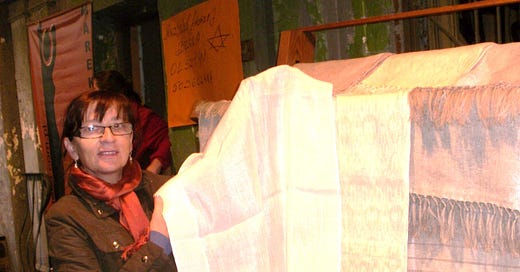Every so often, especially around anniversary time, my wife feels strongly about buying me a Tallis1. She feels, even though we are almost married for thirteen years, that it is her obligation as a spouse.
I always provide a persuasive argument why I do not need a new Tallis. I am very connected to the Tallis I currently wear. I purchased it from the last Tallis maker of Poland.
During August of 2010, I was perusing through the Issac Bashevis Festival in Poland. Such European Jewish festivals do not really interest me. They are kind of kitschy2, but I was in the area, leaving a meeting at the Nozyck Synagogue and the festival was right there so I took advantage of it.
It was a fascinating experience. I passed by a booth in which women were selling custom made Tallises. It raised my curiosity, so I started talking with them. Yes, the Tallises were made in Poland on 19th century looms. They were 100% cotton. A customer could choose the size and the color stripes. The craftsman was not at the festival the time, but the woman gave me his card.
I took the card and filed it when I came home.
Ten months later, after proposing to Denise, I started preparing for our wedding. I called Dariusz Makowski, the Tallis maker, to have him weave a Tallis to be used as our chuppah3, and after the wedding, I intended to use it as my new Tallis.
I provided Dariusz with the dimensions and specified that being traditional, I only wanted black stripes. Being a Kohane4, it had to be a large Tallis to able to cover my head and torso during duchining5 that takes place during Jewish festivals.
The chuppah/Tallis was magnificent. I loved it. I felt a special connection to it being that it came from the old country and was to be used as a chuppah.
I called Dariusz and commended him. I also asked him whether he was interested in marketing outside of Poland. He was, but did not have the marketing skills on how to begin. I offered to help him by doing an “informal” marketing survey to inquire whether there was any interest on his product. The prospect of being a distributor of Tallises from the Old Country excited me.
Dariusz also asked me what else he can do to better his product. I explained to him about shatnes6 and that the fringes of the four sides had to conform to Jewish law. His Tallis contained nice silk threads, but were not acceptable in Jewish law. In fact, I had a Tallis seller in Mea Shearim apply kosher fringes when Denise and I traveled to Israel for our honeymoon.
We agreed to connect four weeks after the conversation. Dariusz was excited. He got shatnes approval and learned how to tie threads to the four corners.
My news for him was forlorn. I asked over two hundred people, friends, relatives, committees, synagogue contacts, whether they would be interested in buying a kosher Tallis from the old country. I continued the pitch that this Tallis could connect them, or perhaps a Bar Mitzvah grandchild/child to their European roots.
No one was interested. Not one. Many of those surveyed were well versed in European history. If even two or four individuals were interested, I would have considered taking the next step. There is a huge difference between zero percent and two percent. I could sense Dariusz’s disappointment. So was I.
I wore my Tallis religiously over the years. It was a part of me, a part of my personal past, a part of my presence and a symbolism of our marriage.
The Tallis started to oxidate, typical of all Tallises, a couple of years ago. Still having Dariusz's card, I tried to call him to order a new Tallis. The line was disconnected. His email address was inoperable. I googled him and tried all permutations to try to get his contact information. No success.
His business apparently closed down. I felt terrible on many levels. There is now no more Tallis makers in Poland. This dedicated, gifted, non-Jewish man who created these wonderful Tallises was nowhere to be found.
In my imagination, I wished Dariusz would have called me. I can envision myself buying his business and marketing his Tallises effectively. I realize that really was a pipedream. Perhaps forty years ago there might have been a market for such Tallises, but we are living in very different times.
Denise and I still have that conversation about obtaining a new Tallis every so often. We are working towards a compromise which is I will wear my current Tallis on weekdays when I go to shul. On Shabbat and Festivals I will wear the beautiful Tallis that Denise will buy.
We are getting there.
A prayer shawl married Jews wear everyday during morning service.
I have since changed my mind about the kitschyness of these festivals. There are aspects of them that are kitschy, but I have met and talked with the most fascinating people and groups at these events.
Wedding Canopy
Those who descended from Aaron, Moses’s brother are part of the Priestly sect.
The ceremony when the priests bless the nation of Israel. Performed during the three festivals and the High Holidays.
Clothing is also subject to certain laws of kashrut.






Another remarkable piece of writing. I’m sure your next Tallis will be extraordinary! Shabbat Shalom to you and Denise